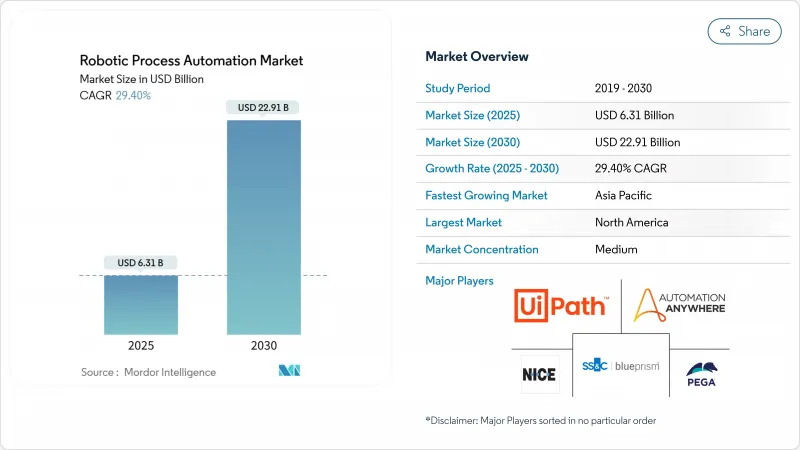
|
市場調査レポート
商品コード
1851741
ロボティックプロセスオートメーション(RPA):市場シェア分析、産業動向、統計、成長予測(2025年~2030年)Robotic Process Automation - Market Share Analysis, Industry Trends & Statistics, Growth Forecasts (2025 - 2030) |
||||||
カスタマイズ可能
適宜更新あり
|
|||||||
| ロボティックプロセスオートメーション(RPA):市場シェア分析、産業動向、統計、成長予測(2025年~2030年) |
|
出版日: 2025年07月17日
発行: Mordor Intelligence
ページ情報: 英文 120 Pages
納期: 2~3営業日
|
概要
ロボティックプロセスオートメーション(RPA)市場規模は、2025年に63億1,000万米ドルと推定され、予測期間(2025-2030年)のCAGRは29.40%で、2030年には229億1,000万米ドルに達すると予測されます。

ジェネレーティブAIと既存のRPAプラットフォームとの統合が進むことで、自動化可能なタスクの幅が広がり、かつては人の介在が必要だった非構造化プロセスへの対応が可能になります。また、導入サイクルを短縮し、支出を営業予算に振り向けるクラウドネイティブの展開も拡大に拍車をかけています。北米は、厳格なコンプライアンスと成熟したテクノロジーエコシステムに支えられ、2024年のロボティックプロセスオートメーション(RPA)市場シェアで39.6%と最大を占め、アジア太平洋地域は、政府が自動化プログラムを後援し、中小企業が従量課金制のボットを採用するため、34.5%と最も速いCAGRを記録しています。ベンダー間の競争は、インテリジェントな文書処理、ローコード設計、自律エージェント機能をプラットフォーム・ロードマップにバンドルするAIに焦点を当てた買収や提携を通じて激化しています。
世界のロボティックプロセスオートメーション(RPA)市場の動向と洞察
小売業のオムニチャネル注文処理自動化
小売企業は、消費者のリアルタイムの期待に応えるため、在庫照合、出荷オーケストレーション、返品管理の自動化を進めています。Grupo Exito社では、eコマースのフロントエンドとレガシーERPデータをリンクさせる全社的なRPAプログラムを導入し、注文処理時間を最大75%短縮しました。コンピュータ・ビジョン・モジュールを統合することで、繁忙期にも98%以上の精度を維持し、AIを活用した需要予測により、サプライチェーンが不安定な中、小売企業はマージン圧力を管理できるようになりました。そのため、成熟したeコマース市場でも新興eコマース市場でも、小売企業は自動化を物流の混乱や労働力不足に対する必要不可欠なヘッジと見なしています。
中小企業によるクラウドネイティブRPAプラットフォームの導入
消費型のSaaSモデルは、中小企業の参入障壁を低くしています。Jana Small Finance Bankは、UiPathのクラウド・サービスに移行後、オンプレミスのインフラを必要とせず、重要なプロセスのターンアラウンド・タイムを約70%短縮しました。ハイパースケールプロバイダーがマーケットプレースにRPAを組み込むことで、中小企業は数日以内に安全なボットを導入し、取引量が増加した場合にのみライセンスを拡張することができます。アナリストは、市民開発者向けツールが成熟し、業界固有のテンプレートが普及するにつれて、2027年までにボットの新規導入の40%以上を中小企業が占めるようになると予測しています。
UIの変更によるボットの持続的な破損
企業やSaaSアプリケーションの頻繁なインターフェイスの更新は、セレクタを混乱させ、ボットを動作不能にします。Tarsus Distributionは、仕入先のフォーマットが変更された際に請求書のワークフローを再設計する必要があり、レガシーな画面スクレイピングボットの脆弱性を浮き彫りにしました。新しいプラットフォームには、オブジェクトベースのセレクタと自己修復機能が追加されていますが、変更管理の欠点がスケーリング計画を遅らせ、初期段階のプログラムに対する信頼を損ない続けています。
セグメント分析
2024年のロボティックプロセスオートメーション(RPA)市場の54.3%はオンプレミス型が占めています。それでもクラウド導入のCAGRは38.2%と最も高く、セキュリティ認証が拡大するにつれてその差は縮まると思われます。UiPathは、新規予約の80%以上がクラウドサブスクリプションによるもので、顧客はオンプレミスよりも50%早くロールアウトを達成していると述べています。欧州の銀行では、機密性の高い決済ワークフローを社内で管理する一方で、設計、テスト、分析にはクラウドのテナントを利用するハイブリッド・パターンが定着しつつあります。この柔軟性により、企業は弾力的なキャパシティを失うことなく、居住義務に対応することができます。
エッジコンピューティングが成熟するにつれ、ベンダーはローカルで実行しながらクラウドからオーケストレーションを受ける軽量なランタイムをパッケージ化しています。このようなアーキテクチャは、サーバー管理のオーバーヘッドを最小限に抑えながら、工場現場のボットの待ち時間を短縮します。その結果、多くの製造業者は、パッチの適用を簡素化し、AIのアップグレードに即座にアクセスできることを理由に、3年以内に非生産用ロボットをSaaSに移行することを計画しています。その結果、サブスクリプション収益が永久ライセンスを追い越し、ロボティックプロセスオートメーション(RPA)市場を後押しし続けると思われます。
2024年にはソフトウェアプラットフォームが売上の51.3%を占めるが、人材中心のチェンジマネジメントが成功の鍵を握っていることを企業が認識するにつれて、サービスは35.1%のCAGRで拡大しています。導入企業は、ディスカバリー、リエンジニアリング、シチズン・デベロッパーのコーチングをバンドルすることが増えており、トランスフォーメーション予算全体の約60%を占めています。SS&C Technologiesは、Blue Prismソフトウェアとアドバイザリーサービスを組み合わせることで、ボット数を3倍に増やし、1億米ドルのコスト削減を実現しました。
インテリジェントな自動化には継続的なAIモデルのチューニングが必要なため、継続的な改善リテーナーの需要も高まっています。ベンダーは現在、個別プロジェクトのマイルストーンではなく、SLAベースの成果を保証するマネージド・サービスを提供しています。このピボットにより、サービスに割り当てられるロボティックプロセスオートメーション(RPA)の市場規模はさらに拡大し、この分野がツールの導入から企業全体のオペレーティング・モデルの再設計へと進んでいることが明らかになりました。
ロボティックプロセスオートメーション(RPA)市場は、デプロイメント(オンプレミス、クラウド/SaaS)、ソリューション・コンポーネント(ソフトウェア、サービス)、企業規模(中小企業、大企業)、テクノロジー・タイプ(アテンドRPA、アンアテンドRPA、インテリジェント/コグニティブRPA)、エンドユーザー産業(BFSI、IT・テレコム、ヘルスケア、その他)、地域別に区分されます。市場予測は金額(USD)で提供されます。
地域別分析
北米は2024年に39.6%のシェアで首位を維持し、政府機関や金融サービスにおける早期導入曲線と厳格なコンプライアンス義務に後押しされました。米国住宅都市開発省などの機関は、RPAと機械学習を組み合わせたアプローチを採用し、給付金処理の近代化を図っています。カリフォルニア州陸運局のような州機関は、ボットを活用してデジタル・ライセンス・サービスを加速し、パンデミックによる混乱時にもサービスを継続できるようにしました。ベンダー情勢は、豊富なシステムインテグレーターの能力と熟練した自動化の専門家から恩恵を受け、継続的なパイプラインの成長を確保しています。
アジア太平洋地域は、CAGR34.5%で最も急成長している地域です。日本のRPAロボパットDXは、中小企業への導入件数が1,700件を突破し、逼迫した労働市場における草の根的な需要を示しています。インドのマニパル病院は、拡大するデジタルヘルス規制に対応するため、財務ワークフローを自動化しました。政府の補助金制度や現地語でのインターフェイス・サポートにより、製造業者やアウトソーシング・ハブでの導入がさらに拡大し、この地域のロボティックプロセスオートメーション(RPA)市場が拡大すると思われます。
欧州では、デジタル・オペレーショナル・レジリエンス法(Digital Operational Resilience Act)が、自動化されたワークフローの文書化とストレステストを銀行に義務付けています。金融機関は、2025年のコンプライアンス期限を満たすために、1行あたり1,500万ユーロに達する複数年予算を計上しています。ドイツの製造業はバックオフィスの自動化を推進し、北欧のヘルスケアシステムは地域全体で共有されたボット・ライブラリーを導入しています。オンプレミスにデータを保持しつつ、クラウドコンソールでオーケストレーションを行うハイブリッドな展開構造が主流になりつつあり、EU加盟国全体でロボティックプロセスオートメーション(RPA)市場の存在感を着実に高めています。
その他の特典:
- エクセル形式の市場予測(ME)シート
- 3ヶ月間のアナリスト・サポート
よくあるご質問
目次
第1章 イントロダクション
- 調査の前提条件と市場の定義
- 調査範囲
第2章 調査手法
第3章 エグゼクティブサマリー
第4章 市場情勢
- 市場概要
- 市場促進要因
- 小売オムニチャネル・オーダー・フルフィルメントの自動化
- クラウドネイティブRPAプラットフォームの中小企業採用状況
- GEN-AIを搭載したボット・デザイン・アシスタント
- ハイパースケールマーケットプレースにおける従量課金ボット
- DORAとHIPAA後のコンプライアンス主導の自動化
- シェアードサービスセンターにおける世界の人材不足
- 市場抑制要因
- UI変更によるボット破損の持続
- 無人ボットのガバナンスと倫理的精査
- レガシーRPAスイートからの高いスイッチングコスト
- 新興市場におけるプロセスの標準化の低さ
- 業界バリューチェーン分析
- 規制情勢
- テクノロジーの展望
- 業界の魅力ポーターのファイブフォース分析
- 供給企業の交渉力
- 買い手の交渉力
- 新規参入業者の脅威
- 代替品の脅威
- 競争企業間の敵対関係
- マクロ経済要因が市場に与える影響
第5章 市場規模と成長予測
- 展開別
- オンプレミス
- クラウド/SaaS
- ソリューション・コンポーネント別
- ソフトウェア(プラットフォームとライセンス)
- サービス(インプリメンテーション、CoE、サポート)
- 企業規模別
- 中小企業(SMEs)
- 大企業
- 技術タイプ別
- アテンド型RPA
- 無人RPA
- インテリジェント/コグニティブRPA
- エンドユーザー業界別
- BFSI
- ITおよび電気通信
- ヘルスケア
- 小売・CPG
- 製造業
- その他のエンドユーザー産業
- 地域別
- 北米
- 米国
- カナダ
- メキシコ
- 南米
- ブラジル
- アルゼンチン
- チリ
- その他南米
- 欧州
- ドイツ
- 英国
- フランス
- イタリア
- スペイン
- ロシア
- その他欧州地域
- アジア太平洋地域
- 中国
- インド
- 日本
- 韓国
- シンガポール
- マレーシア
- オーストラリア
- その他アジア太平洋地域
- 中東・アフリカ
- 中東
- アラブ首長国連邦
- サウジアラビア
- トルコ
- その他中東
- アフリカ
- 南アフリカ
- ナイジェリア
- その他アフリカ
- 北米
第6章 競合情勢
- 市場集中度
- 戦略的動向
- 市場シェア分析
- 企業プロファイル
- UiPath Inc.
- Automation Anywhere Inc.
- SS&C Blue Prism Ltd.
- NICE Ltd.(Robotic Automation)
- Pegasystems Inc.
- Kofax Inc.
- WorkFusion Inc.
- Kryon Systems Ltd.
- EdgeVerve Systems Ltd.
- AntWorks Pte Ltd.
- Laiye Technology Ltd.
- Cyclone Robotics Co. Ltd.
- AutomationEdge Technologies Inc.
- Datamatics Global Services Ltd.
- Nividous Software Solutions
- Soroco
- Redwood Software Inc.
- Microsoft Corp.(Power Automate)
- Servicetrace GmbH
- Jidoka(Novayre Solutions)
- Fortra LLC(ex-HelpSystems)
- ElectroNeek Robotics Inc.
- Robocorp Technologies Inc.
- Robiquity Ltd.
- Rocketbot SpA
- OpenConnect Systems Inc.
第7章 投資分析
第8章 市場機会と今後の動向
- ホワイトスペースとアンメットニーズ評価

